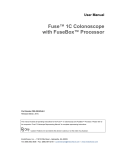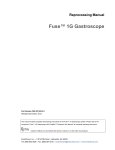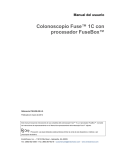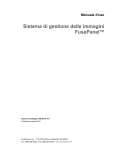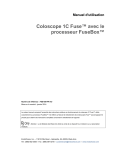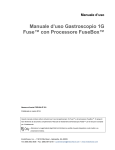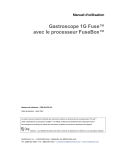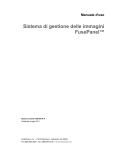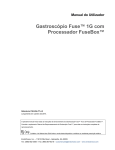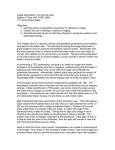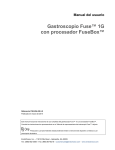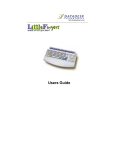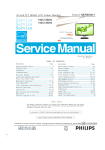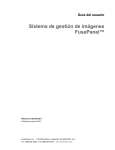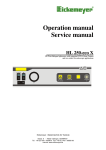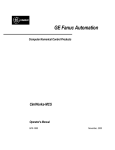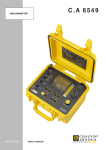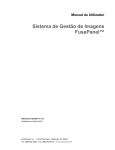Download FSE-054-EN-5.0 Fuse 1G Gastroscope with FuseBox
Transcript
User Manual Fuse™ 1G Gastroscope with FuseBox™ Processor Part Number FSE-054-EN-6.0 Released March, 2014. This manual includes all operating instructions for the Fuse™ 1G Gastroscope and FuseBox™ Processor. Please refer to the companion “Fuse™ Endoscope Reprocessing Manual” for complete reprocessing instructions. Caution: Federal U.S. law restricts this device to sale by or on the order of a physician. EndoChoice, Inc. – 11810 Wills Road – Alpharetta, GA 30009 Tel: (888) 682-3636 – Fax: (866) 567-8218 – [email protected] – www.endochoice.com IMPORTANT: Read this User Manual in its entirety prior to using the Fuse™ 1G Gastroscope. 2014 EndoChoice, Inc. ALL RIGHTS RESERVED. EndoChoice, Inc. reserves the right to alter the equipment specifications and descriptions in this publication without prior notice. No part of this publication shall be deemed to be part of any contract or warranty unless specifically incorporated by reference into such contract or warranty. The information contained herein is merely descriptive in nature, and does not constitute a binding offer for the sale of the product described herein. Neither EndoChoice, Inc. nor its agent make any representations for fitness for any purpose, other than specifically mentioned in this manual. DISCLAIMER EndoChoice, Inc. shall not be obligated in any manner in respect to bodily injury and/or property damage arising from the use of the device if such use is not in strict compliance with instructions and safety precautions contained in the relevant operating manuals and in all supplements thereto, in all product labels, and according to all terms of warranty and sale of this device, or in any change not authorized by EndoChoice, Inc. WARNING User provided ancillary equipment and/or accessories are NOT validated or warranted by EndoChoice, Inc. The use of such user provided items is the sole responsibility of the party using such items. EC ii REP EndoChoice Innovation Center Ltd. European Authorized Representative 2 Hatochen Street Caesarea, 38900, Israel Tel: +972-4-632-7731 Fax: +972-4-632-7734 Email: [email protected] MedNet GmbH Borkstraβe 10 48163 Münster, Germany Tel: +49-251-32266-0 Email: [email protected] FSE-054-EN-6.0 Contents Contents Contents ....................................................................................................... iii Safety Information – Please Read Prior to Use ................................................1 Using this manual ........................................................................................................ 1 Support........................................................................................................................ 1 Summary of instrument symbols ................................................................................. 2 Safety Guidelines – please read prior to use............................................................... 3 User Qualification – please read prior to use .............................................................. 4 Warnings and cautions ................................................................................................ 4 Electrical safety ........................................................................................................... 5 Electric interference safety .......................................................................................... 6 Fire and explosion safety ............................................................................................ 7 Operation environment ................................................................................................ 7 Reprocessing .............................................................................................................. 7 CHAPTER 1 Regulatory Information .............................................................9 1.1 Intended use ...................................................................................................... 9 1.2 USA regulations................................................................................................. 9 1.3 CE conformity .................................................................................................... 9 CHAPTER 2 System Overview .................................................................... 11 CHAPTER 3 System Components................................................................ 13 3.1 3.2 3.3 Fuse™ 1G Gastroscope ...................................................................................13 3.1.1 Packaged components .........................................................................13 3.1.2 Gastroscope – general view .................................................................15 3.1.3 Gastroscope interface...........................................................................16 3.1.4 Gastroscope internal channels .............................................................18 FuseBox™ ........................................................................................................19 3.2.1 Packaged components .........................................................................19 3.2.2 FuseBox™ front panel interface ...........................................................20 3.2.3 FuseBox™ back panel interface ...........................................................21 Specifications ...................................................................................................22 3.3.1 Fuse™ 1G Gastroscope .......................................................................22 3.3.2 FuseBox™ ............................................................................................23 3.3.3 Environment .........................................................................................24 CHAPTER 4 Preparing and Inspecting the System ....................................... 25 Fuse™ 1G Gastroscope with FuseBox™ Processor User Manual iii Contents 4.1 Overview - system connection chart .................................................................25 4.2 Preparation and inspection workflow ................................................................26 4.3 Prepare the Fuse™ 1G Gastroscope ...............................................................27 4.4 4.5 4.6 4.3.1 Reprocess the Fuse™ 1G Gastroscope prior to use ............................27 4.3.2 Inspect the Fuse™ 1G Gastroscope prior to use ..................................27 4.3.3 Connect the suction, air/water and biopsy valves .................................28 4.3.4 Connecting the reusable suction and air/water scope valves ...............29 Set up the FuseBox™ system ..........................................................................30 4.4.1 Connect the FuseBox™ to a power supply...........................................30 4.4.2 Connect the FuseView™ monitors .......................................................30 4.4.3 Select monitor display mode .................................................................30 4.4.4 Connect FusePanel™...........................................................................31 Connect Fuse™ 1G Gastroscope and ancillary equipment to the FuseBox™ .32 4.5.1 Connect the Fuse™ 1G Gastroscope ...................................................33 4.5.2 Connect the water bottle .......................................................................33 4.5.3 Connect the water jet connector to the auxiliary water port ..................34 4.5.4 Connect the irrigation tubing to the water jet connector ........................34 4.5.5 Connect the suction source ..................................................................35 4.5.6 Connect the auxiliary water supply (jet) ................................................36 Inspect the Fuse™ 1G Gastroscope functions .................................................37 4.6.1 Test the angulation mechanism ............................................................37 4.6.2 Turn the FuseBox™ system on ............................................................37 4.6.3 Test the video signal and white balance ...............................................38 4.6.4 Test the insufflation mechanism ...........................................................40 4.6.5 Test the irrigation mechanism ...............................................................41 4.6.6 Test the suction mechanism .................................................................42 4.6.7 Test the auxiliary water mechanism......................................................42 4.6.8 Test the XLUM (blinking) mode ............................................................42 4.6.9 Test the Capture function .....................................................................43 4.6.10 Test the Record function.....................................................................43 4.6.11 Test the Timer function .......................................................................43 4.6.12 Test the Zoom function .......................................................................43 4.6.13 Test the Freeze/Release function .......................................................43 CHAPTER 5 5.1 iv Understanding the FuseBox™ System Screens and Functions.... 45 User screens ....................................................................................................45 5.1.1 Navigating the GUI ...............................................................................45 5.1.2 FuseBox™ main screen .......................................................................45 FSE-054-EN-6.0 Contents 5.2 5.1.3 Setup screen 1 – image settings ..........................................................47 5.1.4 Setup screen 2 – LED intensity ............................................................48 5.1.5 Setup screen 3 – system / scope information .......................................49 5.1.6 Setup screen 4 – monitor selection (1-2-3 monitors) ............................50 5.1.7 Light mode ............................................................................................51 5.1.8 Timer ....................................................................................................52 5.1.9 XLUM (Distal Tip LED blinking) mode ..................................................52 System functions ..............................................................................................53 5.2.1 Capture image ......................................................................................53 5.2.2 Video recording ....................................................................................54 5.2.3 Timer ....................................................................................................55 5.2.4 Zoom ....................................................................................................56 5.2.5 Freeze/Release image..........................................................................56 CHAPTER 6 6.1 Performing the Procedure ....................................................... 57 Important safety information .............................................................................57 6.1.1 Examples of improper handling ............................................................57 6.1.2 Using nonflammable gases ..................................................................58 6.2 Inserting the gastroscope .................................................................................58 6.3 Using endoscopic devices and accessories .....................................................58 6.4 6.3.1 Using endoscopic accessories .............................................................59 6.3.2 Using electrosurgical accessories ........................................................59 Withdrawing the gastroscope ...........................................................................60 CHAPTER 7 Storage and Handling .............................................................. 61 7.1 Servicing ...........................................................................................................61 7.2 Disassembly .....................................................................................................61 7.3 Transportation ..................................................................................................61 7.4 Storage .............................................................................................................62 CHAPTER 8 Troubleshooting ...................................................................... 63 8.1 Troubleshooting the Fuse™ 1G Gastroscope ..................................................63 8.2 Withdrawal of the gastroscope with no image ..................................................64 Appendix ..................................................................................................... 65 Compatible accessories .............................................................................................65 EMC Information ........................................................................................................67 Compliance information and recommended electromagnetic emission .............67 Compliance information and recommended electromagnetic immunity ............68 Cautions and recommended electromagnetic environment ..............................69 Recommended separation distance ..................................................................70 Fuse™ 1G Gastroscope with FuseBox™ Processor User Manual v Contents Warranty.....................................................................................................................71 vi FSE-054-EN-6.0 Safety Information – Please Read Prior to Use Safety Information – Please Read Prior to Use Using this manual This manual provides information required to enable you to use the Fuse™ 1G Gastroscope with FuseBox™ Processor system. Read this manual thoroughly before using the device and ensure that you understand the proper use of and care for the device. If you have any questions or comments regarding the use of the device, please contact EndoChoice, Inc. Note that the complete instruction manual set for this endoscope also includes the companion “Fuse™ Endoscope Reprocessing Manual”. The following conventions are used in this manual: Symbol Description WARNING A warning is a statement that alerts / indicates a potentially hazardous situation associated with the use or misuse of the device, which, if not avoided, could result in serious injury or death. A caution is a statement that alerts / indicates a potentially hazardous situation associated with its use or misuse which may, if not avoided, result in minor or moderate injury. It may also be used to alert against unsafe practices or potential equipment damage. CAUTION: An informational note provides additional information of interest to the user. Support Outside the United States United States EndoChoice GmbH Otto-Hahn-Str. 11 25337 Elmshorn Germany EndoChoice, Inc. 11810 Wills Rd. Alpharetta, GA 30009 +49 (0) 4121-649390 Phone +49 (0) 4121-649383 Fax 888-682-ENDO (3636) Phone 866-567-8218 Fax Fuse™ 1G Gastroscope with FuseBox™ Processor User Manual 1 Safety Information – Please Read Prior to Use Summary of instrument symbols Symbol Description Serial number Consult instructions for use Attention, see instructions Shock protection type (BF) Power button Equipotentiality Manufactured by Catalog number Must not be disposed of as unsorted municipal waste but should be collected separately. Number of units CE Mark (Class IIa) EC REP European Representative Federal US law restricts this device for sale by or on the order of a physician. Non-sterile Manufacturing date Manufactured according to Restriction of Hazardous Substances Directive 2 FSE-054-EN-6.0 Safety Information – Please Read Prior to Use E364813 Medical Electrical Equipment WITH RESPECT TO ELECTRICAL SHOCK FIRE, AND MECHANICAL HAZARDS ONLY IN ACCORDANCE WITH UL60601-1 / CAN/USA C22.2 No. 601.1 / IEC60601-2-18 E363751 Medical Electrical Equipment WITH RESPECT TO ELECTRICAL SHOCK FIRE, AND MECHANICAL HAZARDS ONLY IN ACCORDANCE WITH AAMI ES60601-1, CAN/CSA C22.2 No. 60601-1-08 / IEC60601-2-18 Safety Guidelines – please read prior to use This product was designed and manufactured to meet all safety requirements applicable to electronic medical equipment. However, anyone operating the system must be fully aware of the potential safety hazards. It should be operated and maintained in strict compliance with the safety precautions and operating instructions contained herein. This product must be installed, maintained, and serviced by EndoChoice qualified service personnel. Operation and maintenance must be done in strict compliance with the operation instructions contained in the manual. The system is not to be modified in any way. Any attempt to disassemble, repair, or modify this device by anyone other than an EndoChoice authorized service technician presents risk to the patient or operator and may result in equipment damage. Equipment that has been disassembled, repaired, altered, changed, or modified by persons other than EndoChoice’s own authorized service personnel is excluded from EndoChoice’s warranty and is not warranted by EndoChoice in any way. Where applicable, follow the official standards on the applicability of gastroscopy and gastroscopic treatment that are defined by the hospital’s administrators or other official institutions, such as academic societies on endoscopy. Before starting gastroscopy and gastroscopic treatment, thoroughly evaluate its properties, purposes, effects, and possible risks (their nature, extent and probability). Procedures and treatment should only be performed when the potential benefits outweigh the risks. Immediately stop the procedure if the patient risks exceed the potential benefits. Do not use the system if unsafe conditions exist. In the event of hardware failure that could potentially cause hazardous conditions (smoke, fire, etc.), turn the power off and unplug the power cord. In the event of product malfunction, discontinue operation and contact an authorized service person immediately. Fuse™ 1G Gastroscope with FuseBox™ Processor User Manual 3 Safety Information – Please Read Prior to Use User Qualification – please read prior to use The Fuse™ 1G Gastroscope should only be used by a physician who is well trained and capable of performing the planned gastroscopy and gastroscopic treatment. This manual does not explain or discuss endoscopic procedures. The manufacturer or vendor of the equipment makes no claim that the act of reading this manual renders the reader qualified to operate the system. It is important that this manual remain available, studied carefully, and reviewed periodically by the authorized operators. All external components connected to the Fuse™ system (such as monitors, printer, etc.) should be medical grade only. Warnings and cautions Follow the warnings and cautions given below when handling this endoscope. This information is to be supplemented by the warnings and cautions provided in each chapter. WARNING Following endoscope use, clean, reprocess and store it according to the instructions found in the endoscope’s companion “Fuse™ Endoscope Reprocessing Manual”. Using instruments that have either been improperly or incompletely reprocessed or stored may cause cross-contamination or infection. Before endoscopy, remove any metallic objects (watch, glasses, necklace, etc.) from the patient. Performing high-frequency cauterization treatment while the patient is wearing metallic objects may cause burns on the patient in areas around a metallic object. Do not strike, hit, or drop the endoscope’s Distal End, Bending Section, Insertion Tube, Umbilical Tube, Control Handle, or endoscope Connector. Also, do not bend, pull, or twist the endoscope’s Distal End, Insertion Tube, Bending Section, Control Handle, Umbilical Tube, or endoscope Connector with excessive force. The endoscope may be damaged and could cause patient injury, burns, bleeding, and/or perforations. Never perform angulation control forcibly or abruptly. Never forcefully pull, twist, or rotate the angulated Bending Section. Patient injury, bleeding, and/or perforation may result due to unintended retroflexion of the Bending Section. It may also become impossible to straighten the Bending Section during an examination. Never insert or withdraw the endoscope’s insertion section while the Bending Section is locked in position. Patient injury, bleeding, and/or perforation may result. Never operate the Bending Section, feed air or perform suction, insert or withdraw the endoscope’s insertion section, or use accessories without viewing the endoscopic image or while there is no image. Patient injury, bleeding, and/or perforation may result. Never insert or withdraw the insertion section abruptly or with excessive force. Patient injury, bleeding, and/or perforation may result. 4 FSE-054-EN-6.0 Safety Information – Please Read Prior to Use If it is difficult to insert the endoscope, do not forcibly insert the endoscope; stop the endoscopy. Forcible insertion can result in patient injury, bleeding, and/or perforation. The temperature of the endoscope’s Distal Tip may exceed 41°C (106°F) due to endoscopic illumination. As surface temperatures over 41°C (106°F) may cause mucosal burns, always maintain a distance suitable for adequate viewing while using the minimum illumination level for the minimum length of time. Do not use stationary viewing in close proximity to the mucous membrane or leave the Distal Tip of the endoscope close to the mucous membrane for an extended length of time without necessity. CAUTION: Do not attempt to manually bend the endoscope’s insertion section. Insertion section damage may result. Do not hit or impact the Distal End of the insertion section, especially the objective lens surface at the Distal End and side. Damage may affect the image. Do not twist, squeeze or bend the Bending Section with your hands. Equipment damage may result. Electromagnetic interference may occur on this endoscope near portable and mobile RF (Radio Frequency) communications equipment, such as cellular phones. Check electromagnetic interference from other equipment prior to use. Shielding or relocation of the device may be necessary if interference occurs. If there is a change in lighting quality during the procedure, or if the image dims during the procedure, tissue or debris might have adhered to the Distal End. Slowly extract the endoscope to avoid an increase in temperature. Electrical safety The multiple portable socket outlet (power strip) used with the Fuse™ system shall only be used for powering equipment which forms a part of the Fuse™ system. Maximum load on the U.S. power strip (EDSB-486) is 12A–120V. Maximum load on the international power strip (FSA-2064) is 10A-250V. Do not connect any non-medical equipment supplied with the Fuse™ system (such as the printer) directly to the wall outlet when the system is supplied via a power strip with a separating transformer. Connect supplied non-medical Fuse™ system equipment to the isolation transformer only. A power cable is supplied with the system to provide the appropriate electrical grounding. To minimize the potential for electrical shock, the power cable must be plugged into an approved grounded electrical outlet. Do not use an adapter to plug the system into an ungrounded outlet. Do not operate the system if damaged wires or open leads are detected. Fuse™ 1G Gastroscope with FuseBox™ Processor User Manual 5 Safety Information – Please Read Prior to Use Do not remove or open system covers. The operator should never open the panels of the system. Only qualified personnel are authorized to maintain and service the system. Be sure to install the Fuse™ system equipment in one of the recommended combinations for optimal use. If combinations other than those shown throughout this and other Fuse™ manuals are used, optimal operation cannot be assured. WARNING Do not place a power strip on the floor. Do not connect an additional power strip to the system. Do not connect items which are not specified as part of the Fuse™ system. Using incompatible equipment can result in patient or operator injury and/or equipment damage, and will increase the leakage current. CAUTION The use of ACCESSORY equipment not complying with the equivalent safety requirements of this equipment may lead to a reduced level of safety of the resulting system. Consideration relating to the choice shall include: 1.) use of the accessory in the PATIENT VICINITY, and 2.) evidence that the safety certification of the ACCESSORY has been performed in accordance to the appropriate IEC 60601-1 and/or IEC 60601-1-1 harmonized national standard. (Refer to the Appendix for a list of compatible accessories.) Electric interference safety This equipment generates and can radiate radio frequency energy. The equipment may cause radio frequency interference to other medical and non-medical devices as well as to radio communications. To provide reasonable protection against such interference, the system complies with the IEC60601-1-2 standard*. If the device is suspected of interfering with other nearby electrical equipment, power down the device to see if the interference is eliminated. If the endoscope system is determined to be the source of interference, additional shielding or relocation of the device or neighboring equipment may be necessary. Use of improperly shielded and grounded cables may result in the equipment causing radio frequency interference in violation of the local regulations. The manufacturer is not responsible for any interference caused by using cables other than those recommended or by unauthorized changes or modifications to this equipment. Do not use devices that intentionally transmit RF signals (cellular phones, transceivers, or radio-controlled products) in the vicinity of this equipment as it may cause performance outside the published specifications. Keep the power of these types of devices turned off when located near this equipment. The medical staff in charge of this equipment is required to instruct technicians and other people who may be around this equipment to fully comply with the above requirement. 6 FSE-054-EN-6.0 Safety Information – Please Read Prior to Use Fire and explosion safety Conductive fluids that drain into the active circuit components of the system may cause short circuits potentially resulting in electrical fire. Do not block the ventilation ports of the electronic equipment. Always maintain a minimum 6-inch (15 cm) clearance around the ventilation ports to prevent overheating and damage to the electronic hardware. To avoid electric shocks and burns potentially caused by application of the wrong type of fire extinguisher, ensure that the fire extinguisher at the site has been approved for use on electrically induced fires. Do not operate the equipment in the presence of flammable or explosive liquids, vapors or gases such as flammable anesthetic, oxygen or nitrous oxide. Do not plug in or turn on the system if hazardous substances are detected in the environment. If flammable substances are detected after the system has been turned on, do not attempt to turn off the system or unplug it. Evacuate and ventilate the area before turning the system off. Do not operate in the presence of explosive gas concentrations in the area of use of high frequency endoscopically-used accessories. See also, Section 6.1.2, “Using nonflammable gases”. Operation environment Do not place any object on top of the FuseBox™ hardware. These objects may prevent proper cooling of the electronic equipment. The system should not be exposed to a wet or humid environment. When positioning the system, make sure that the main plug and socket are accessible. Avoid exposing the system to direct sunlight or other heat sources. Reprocessing The Fuse™ 1G Gastroscope is a flexible semi-critical device that contacts intact mucus membranes or non-intact skin. Therefore, as with any other flexible endoscopes, it must be reprocessed to be free from all microorganisms before use. The FDA recommends reprocessing by thoroughly cleaning this device and then by performing appropriate disinfection. Validated procedures for reprocessing this device are provided in the “Fuse™ Endoscope Reprocessing Manual”. The Fuse™ 1G Gastroscope was not reprocessed before shipment. Before first time use, reprocess the device according to the instruction provided in the companion “Fuse™ Endoscope Reprocessing Manual”. After use, reprocess and store according to the “Fuse™ Endoscope Reprocessing Manual”. Improper and/or incomplete reprocessing or storage can create an infection control risk, cause equipment damage, or reduce performance. Fuse™ 1G Gastroscope with FuseBox™ Processor User Manual 7 Safety Information – Please Read Prior to Use This page intentionally left blank 8 FSE-054-EN-6.0 Regulatory Information CHAPTER 1 Regulatory Information 1.1 Intended use The Fuse™ system is intended for diagnostic visualization of the digestive tract. The system also provides access for therapeutic interventions using standard endoscopy tools. The Fuse™ system consists of EndoChoice camera heads, endoscopes, video system, light source and other ancillary equipment. The Fuse™ 1G Gastroscope in conjunction with the FuseBox™ processor is indicated for use within the upper digestive tract (including the esophagus, stomach and duodenum). 1.2 USA regulations CAUTION: Federal U.S. law restricts this device to sale by or on the order of a physician. 1.3 CE conformity EC REP EndoChoice Innovation Center Ltd. 2 Hatochen Street Caesarea, 38900, Israel Tel: +972-4-632-7731 Fax: +972-4-632-7734 Email: [email protected] MEDNET GmbH BorkStraβe 10 Munster, Germany, 48163 Tel: +49-251-32266-0 Email: [email protected] This device complies with the requirements of Directive 93/42/EEC concerning medical devices. Classification: Class IIa. In the European Union, the following symbol indicates that when the last user wishes to discard this product, it must be sent to appropriate facilities for recovery and recycling. Contact your local EndoChoice representative for additional information on the collection and recovery programs available for this product. Fuse™ 1G Gastroscope with FuseBox™ Processor User Manual 9 Regulatory Information This page intentionally left blank 10 FSE-054-EN-6.0 System Overview CHAPTER 2 System Overview The Fuse™ system is an endoscopic platform indicated to provide visualization and therapeutic access to the upper intestinal tract in the adult population. The Fuse™ system is a wide field of view endoscopic system. The Fuse™ 1G Gastroscope must be used in conjunction with the FuseBox™. The following table provides catalog and model numbers for the Fuse™ 1G Gastroscope and FuseBox™. Table 1. Fuse™ 1G Gastroscope System Catalog Numbers Catalog Number Description FSG-2500-ST Fuse™ 1G Gastroscope FSP-100 FuseBox™ Processor FSR-2004 White Balance Cap FusePanel™ Image Management System: FSA-2015 FusePanel™ Keyboard Video Capture Device Remote Control Cable USB Extension Cord SFU-458 Air/Water Reusable Scope Valve SFU-463 Suction Reusable Scope Valve Endoscope Reprocessing Adaptor Kit*: FSR-3300-KT Air/Water Suction Cleaning Adapter Working Channel Cleaning Adaptor Soaking Cap (also available separately, see below) Water Jet Connector Tube Assembly Cleaning Plugs HPP-2313-10 Valve O-Rings FSA-4240 Auxiliary Water Port Cap SIT-470-100 Water Jet Connector, Disposable SBC-460-10 Seal Biopsy Valve, Reusable SBC-365-100 Seal Biopsy Valve, Disposable SCT-468 Water Bottle Cap and Tubing Set, Reusable SCT-466 Water Bottle Cap and Tubing Set, Disposable Fuse™ 1G Gastroscope with FuseBox™ Processor User Manual 11 System Overview FSR-2000 Endoscope Leak Tester* FSR-2001 Soaking Cap* * See the “Fuse™ Endoscope Reprocessing Manual” for reprocessing steps for these products. In this document, the Fuse™ 1G Gastroscope may be referred to as the gastroscope, and the camera head may be referred to as the Distal Tip or Distal End. The FuseBox™ serves as a control platform for the Fuse™ 1G Gastroscope. The FuseBox™ is responsible for image processing, transferring video signals from the gastroscope, pneumatic control, and control of various external accessories that interface with the system. The Fuse™ 1G Gastroscope is an adult-sized wide field of view video gastroscope. It has a 9.8mm Insertion Tube, a large 2.8mm channel; it also incorporates a dedicated forward water jet feature. The Fuse™ system features multiple viewing options: 160° (standard) and 245° (wide). The wide (245°) mode includes the 160° standard front field of view. The operator can change the viewing mode from 160° to 245° or 245° to 160° by selecting the appropriate monitors using the FuseBox™ interface. 12 FSE-054-EN-6.0 System Components CHAPTER 3 System Components 3.1 Fuse™ 1G Gastroscope 3.1.1 Packaged components The Fuse™ 1G Gastroscope and the gastroscope’s accessories come packaged in a portable case and an accessories box. Open the packaging and carefully remove the gastroscope and the gastroscope accessories. Verify that all of the following items are included in the packaging: 1 2 3 4 5 6 7 8 9 10 11 12 Item # Name of Item Function 1 Fuse™ 1G Gastroscope Gastroscope 2 Working Channel Cleaning Adapter Enables cleaning the working channel; adaptor and accompanying silicone tube are attached to the Biopsy Port. 3 Endoscope Case Case that houses the gastroscope upon delivery. 4 Soaking Cap Used during the leak test and cleaning process. 5 Air/Water Channel Cleaning Adaptor Enables cleaning of the Air/Water and working channels and is attached to the Air/Water and Suction Ports. 6 Leak Tester Used to test for leaks in the gastroscope and is attached to the Leak Tester Port on the Main Connector. Fuse™ 1G Gastroscope with FuseBox™ Processor User Manual 13 System Components 7 Spare O-Ring Set Used for O-Ring replacement in the valves. 8 Biopsy Valve The cap is attached to the Biopsy Port. Instruments are inserted through the Biopsy Valve into the work channel. 9 Air/Water Reusable Scope Valve Covering the hole on top of the valve enables insufflation (pressurized air delivered to the Distal Tip). Depressing the valve enables water to pass to the Distal Tip for lens washing. 14 10 Suction Reusable Scope Valve Depressing the valve creates negative pressure in the work channel; activates suction to remove fluids, debris, flatus, or air from the patient. 11 Water Jet Cleaning Adaptor Connects the cleaning apparatus to the water jet port. np Water Jet Cap Used to close the Water Jet Port when it is not in use. (Not pictured) 12 Fuse™ 1G Gastroscope with FuseBox™ Processor User Manual and Reprocessing Manual Provides information and instructions for using and maintaining the Fuse™ 1G Gastroscope with FuseBox™ Processor. FSE-054-EN-6.0 System Components 3.1.2 Gastroscope – general view 2 3 1 6 5 4 Item # Name of Item Function 1 Insertion Tube The Insertion Tube is the main shaft of the gastroscope and contains the working channel, air/water channel, and video cable. The Insertion Tube has markings to indicate the gastroscope’s location within the upper GI tract. 2 Main Connector The Main Connector connects the gastroscope to the FuseBox™. The Main Connector contains the video socket, S-cord connector, auxiliary water port, Air/Water Bottle Port, and leak tester connector. 3 Umbilical Tube The Umbilical Tube is a hollow tube that connects the gastroscope’s FuseBox™ connector to the Control Handle and contains the suction and air/water channels, and the video cable. 4 Distal Tip The Distal Tip contains the video assembly, light sources, work channel outlet, and air/water outlets. 5 Bending Section The Bending Section enables angulation of the tip of the gastroscope. The Bending Section’s movement is controlled by the angulation knobs. 6 Control Handle The Control Handle contains the angulation knobs, angulation brakes, Suction Opening, air/water opening, and Biopsy Port. Fuse™ 1G Gastroscope with FuseBox™ Processor User Manual 15 System Components 3.1.3 Gastroscope interface 4 5 6 7 8 9 10 11 2 12 3 13 1 Fuse 1C Colonoscope pictured. Item # Name of Item Function 1 Leak Tester Port Connects the Leak Tester to the gastroscope. 2 Suction Port Connects the suction source to the gastroscope. 3 4 Grounding / S-cord port Air/Water Bottle Port Connect the gastroscope with the electrosurgical unit via the Scord. The S-cord conducts leak current from the gastroscope to the electrosurgical unit. To connect the S-cord, refer to the instruction manual for the electrosurgical unit. Connects the Air/Water bottle to the gastroscope. Connects the auxiliary water supply tube to the gastroscope. This threaded port is also referred to as the water jet connector. 16 5 Auxiliary Water Supply Port 6 Left/Right Angulation Knob Brake When an auxiliary water supply is not connected, make sure the cap is on. When this knob is turned so that the F>RL is near the ^L mark, the Distal Tip is unlocked. When this knob is turned so that the F>RL is near the ^R mark, the Distal Tip is locked (will hold in the set position). FSE-054-EN-6.0 System Components Item # Name of Item Function 7 Left/Right Angulation Control Knob When this knob is turned in the “R” direction, the Bending Section moves RIGHT; When this knob is turned in the “L” direction, the Bending Section moves LEFT. 8 Up/Down Angulation Control Knob When this knob is turned in the “U” direction, the Bending Section moves UP; When this knob is turned in the “D” direction, the Bending Section moves DOWN. 9 Up/Down Angulation Knob Brake Moving this lock counter clockwise locks the Up/Down angulation. Moving the lock in the opposite direction disengages the Up/Down angulation brake. 10 Auxiliary Button Housing Contains five (5) auxiliary buttons with textural numerals: 1 = Capture/Print image 2 = Record/Stop recording image 3 = Timer 4 = Zoom (toggles through 6 zoom levels) 5 = Freeze/Release (unfreeze) image 11 Suction Opening Attach the Suction Reusable Scope Valve to this opening. 12 Air/Water Opening Attach the Air/Water Reusable Scope Valve to this opening. 13 Biopsy Port Attach the Biopsy Valve to this opening. Fuse™ 1G Gastroscope with FuseBox™ Processor User Manual 17 System Components 3.1.4 Gastroscope internal channels 18 Item # Name of Item 1 Air/Water Nozzles 2 Air Channel 3 Water Channel 4 Suction/Working Channel 5 Biopsy Port 6 Air/Water Reusable Scope Valve 7 Suction Reusable Scope Valve 8 Suction Channel 9 Air Channel 10 Water Channel 11 Auxiliary Water Channel 12 Water Bottle FSE-054-EN-6.0 System Components 3.2 FuseBox™ 3.2.1 Packaged components Carefully remove the FuseBox™ from its packaging. Verify that the following items are available: 1 2 3 Item # Name of Item Function 1 FuseBox™ The control platform for the Fuse™ 1G Gastroscope 2 AC Cable (power cable) Provides power to the FuseBox™ 3 White Balance Cap Proprietary white balance tool 4 User Manual (Flash drive) Provides information and instructions for using the FuseBox™ Fuse™ 1G Gastroscope with FuseBox™ Processor User Manual 19 System Components 3.2.2 FuseBox™ front panel interface 6 1 2 4 5 Item # Name of Item Function 1 ON/OFF Button Turns the system ON/OFF 2 Main Connecter Socket Connect the gastroscope to this opening. 3 White Balance Button Perform white balance by pressing and holding for longer than 2 seconds. Air Flow Button 4 20 3 Controls the operation of the pump. Pressing the pump level button toggles the pump operation level. There are three LEDs on each side of the button. The LEDs indicate the following: No LEDs lit = Pump is OFF Bottom LEDs lit = Pump is operating at a low level Middle and bottom LEDs lit = Pump is operating at a medium level All LEDs lit = Pump is operating at a high level 5 LED Button Illuminates the Distal Tip LEDs. Toggles between ON/OFF. 6 System Main Screen User interface touch screen np Water Bottle Holder Mounts on side of FuseBox™ or on the side of the FuseCart™, using hardware provided. (Not pictured) np Reusable Water Bottle Mounts on Water Bottle holder, applied to side of FuseBox™ or on the side of the FuseCart™, using the hardware provided. (Not pictured) np White Balance Cap Used to conduct the white balance test. Magnetically mounts to the side of the FuseBox™. (Not pictured) FSE-054-EN-6.0 System Components 3.2.3 FuseBox™ back panel interface 11 10 1 2 9 8 7 6 5 4 3 Item # Name of Item Function 1 ON/OFF Main Power Button Switch ON/OFF the power supply to the FuseBox™ 2 Power Socket Connects the power cord to supply the AC power 3 Left Video Connection (Y/C, Composite, DVI, YPbPr) Connects video signal to a monitor 4 Center Video Connection (Y/C, Composite, DVI, YPbPr) Connects video signal to a monitor 5 Right Video Connection (Y/C, Composite, DVI, YPbPr) Connects video signal to a monitor. 6 Video In (Y/C, Composite, DVI, YPbPr) Allows AUX video input. Reserved for future versions. 7 I/O Port, RS232 Ports Reserved for future versions 8 USB and Ethernet Ports USB: Keyboard, mouse and external drive connection Ethernet: Reserved for future versions 9 Audio Ports Reserved for future versions 10 Equipotential Pin When connected to a potential equalization terminal of another device, the electrical potentials of the devices are equalized. 11 Remote Control Ports Allows remote device connection (FusePanel™) Fuse™ 1G Gastroscope with FuseBox™ Processor User Manual 21 System Components 3.3 Specifications 3.3.1 Fuse™ 1G Gastroscope Function/Feature Description Details Optical System Field of view Standard view 160˚ Wide view 245˚ Direction of view Front and side views (side views shown here are pictured as its RIGHT side) Depth of field 3.0-100 mm Distal End outer diameter 10.5 mm Insertion Tube Distal End FRONT VIEW 2 3 1 4 5 (Right side view shown.) 1. Air/Water front nozzle 2. LED cover 3. Front lens 4. Jet (auxiliary water) channel opening 5. Working channel opening SIDE VIEW Working Channel 22 1. LED cover 2. Side lens 3. Air/Water side nozzle Insertion Tube outer diameter 9.8 mm Working Channel inner diameter 2.8 mm FSE-054-EN-6.0 System Components Function/Feature Description Details Direction from which endoscope accessories enter the endoscopic image Bending Section Angulation range Working length Degree of protection against electric shock Up/Down 210˚ / 120˚ Left/Right 120˚ 105 cm Type BF applied part 3.3.2 FuseBox™ Function Power Feature Value Voltage 115 V - 230 V Frequency 50 Hz / 60 Hz Voltage Fluctuation +/- 10% Max Power 300 W Fuse™ 1G Gastroscope, Fuse™ 1C Colonoscope Scope Compatibility Video Signals 3 x Y/C Analog Video Output 3 x Composite (NTSC) Control Signals Digital Video Output 3 x DVI White Balance Activation via Front Panel Pump Control Off, Low, Medium, High Light Control Light ON/OFF Weight 14.5 kg Dimensions 350 mm x 170 mm x 450 mm Electrical class & Electrical type Class I , Type BF Air Pump Type Diaphragm Pump Max Pressure 45 kPa Irrigation flow Rate (when connected to Fuse™ 1G Gastroscope) 1.25 cm3/s Fuse™ 1G Gastroscope with FuseBox™ Processor User Manual 23 System Components 3.3.3 Environment Environment Value Operating Conditions Temperature + 5C (41F) +40C (104F) Relative Humidity Uncontrolled 85% RH Transportation and Storage Conditions 24 Temperature - 29C (-20F) +38C (100F) Relative Humidity Uncontrolled – 85% RH FSE-054-EN-6.0 Preparing and Inspecting the System Preparing and Inspecting the CHAPTER 4 System This chapter provides an overview of the system’s setup, and instructions for system preparation and inspection. 4.1 Overview - system connection chart Monitors FusePanel™ FuseBox™ Printer (Optional) Fuse™ Endoscope Auxiliary Water Supply Suction Source Endoscopic Tools Water Bottle Fuse™ 1G Gastroscope with FuseBox™ Processor User Manual 25 Preparing and Inspecting the System 4.2 Preparation and inspection workflow WARNING The Fuse™ 1G Gastroscope must be inspected for device integrity before use. Do not use the Fuse™ 1G Gastroscope if it appears damaged or has missing parts. Using an instrument that is damaged or incomplete may compromise the patient or operator’s safety and may result in equipment damage or personal injury. If the Fuse™ 1G Gastroscope appears damaged or has missing parts, contact your EndoChoice representative before using the device. The gastroscope was not cleaned and high-level disinfected before shipping, therefore, it MUST be cleaned and high-level disinfected prior to its first use. Refer to the “Fuse™ Endoscope Reprocessing Manual” for the validated cleaning and high-level disinfection procedures for this device. Failure to clean and high-level disinfect the device will increase the risk of patient infection. Wear personal protective equipment such as protective gloves, eyewear, and facemask to ensure user safety. Failure to do so could lead to infection control risk. The following table illustrates the preparation and inspection process for the Fuse™ 1G Gastroscope. Before each use, it is the operator’s responsibility to prepare and inspect all equipment/accessories to be used in conjunction with the Fuse™ 1G Gastroscope as per their respective instructions for use. Should any irregularities occur, refer to Chapter 8 Troubleshooting. Table 2. FUSE™ System Preparation and Inspection Process Step # Section Description 1 4.3.1 Reprocess the endoscope system before use. 2 4.3.2 Inspect the endoscope. 3 4.3.3 Inspect the accessories and connect to the endoscope. 4 4.3.4 Set up the FuseBox™ system. 5 4.5 Connect the endoscope and accessories to the FuseBox™. 6 0 Inspect system functionality. Spare/Backup Equipment: Preparation of another gastroscope, related accessories, and backup generator is recommended to avoid unexpected procedure termination / interruption due to equipment failure or malfunction. 26 FSE-054-EN-6.0 Preparing and Inspecting the System 4.3 Prepare the Fuse™ 1G Gastroscope 4.3.1 Reprocess the Fuse™ 1G Gastroscope prior to use Refer to the “Fuse™ Endoscope Reprocessing Manual” for detailed instructions. 4.3.2 Inspect the Fuse™ 1G Gastroscope prior to use Visually inspect the Control Handle for excessive scratching, deformation, loose parts, missing parts, or other irregularities. Visually inspect the Insertion Tube section specifically the section interfacing with the Control Handle for bends, twists, or other irregularities. Visually inspect the external surface of the entire insertion section including the Bending Section and the Distal End for dents, swelling, scratches, holes, bends, adhesion of foreign bodies, missing parts, protruding objects, or other irregularities. Holding the control section with one hand, carefully run your other hand back and forth over the entire length of the insertion section. Confirm that no rough surfaces, sharp edges, objects or metallic wire protrude from the outer surface of the insertion section, nor from any endoscopically-used accessories. Also, confirm that the Insertion Tube is not abnormally rigid. Visually confirm that all the markings on the Insertion Tube are clearly visible. Visually inspect the two objective lenses (located at the front and the left side of the Distal Tip) for scratches, cracks, stains, openings around the lens, or other irregularities. Visually inspect the two air/water nozzles (located at the front and the left side of the Distal Tip) for abnormal swelling, dents, blocks, scratches, stains, missing parts, or other irregularities. Using both hands, gently bend the Insertion Tube (not the Bending Section near the Distal Tip) of the endoscope into a semicircle. Then, moving your hands confirm that the entire Insertion Tube can be smoothly bent to form a semicircle and that the Insertion Tube is flexible. Gently hold your finger in the middle of the Bending Section. Gently push and pull with your other hand the Insertion Tube to ensure that the joint between the Bending Section and the Insertion Tube is not loose. Wipe dry the endoscope connector, including the electrical contacts, using sterile, clean, lint-free cloths. Also confirm that the electrical contacts are completely dry and clean. Fuse™ 1G Gastroscope with FuseBox™ Processor User Manual 27 Preparing and Inspecting the System 4.3.3 Connect the suction, air/water and biopsy valves 1. Push the Suction Reusable Scope Valve into the Suction Opening of the gastroscope and turn until you feel it drop into position. Visually confirm the valve is seated properly. 2. Push the Air/Water Reusable Scope Valve into the air/water opening until it is securely in place. Visually confirm the valve is seated properly. 3. Attach the flat end of a Biopsy Valve onto the Biopsy Port, and twist the cap clockwise to ensure that it is on tightly. Verify that the Biopsy Valve is closed. WARNING Improper handling of the Biopsy Valve may pose an infection control risk or degrade or prevent correct device function. Observe the following warnings when using the Biopsy Valve: 28 FSE-054-EN-6.0 Preparing and Inspecting the System o Refer to the manufacturer instructions for use for the Biopsy Valve. Failure to follow instructions for use can result in patient infection, device contamination, degraded performance, or loss of functionality. o Prior to use, inspect the Biopsy Valve package and the product, itself, for signs of damage or tampering. If tampering or damage exists to the cap or its package, do not use. o If the Biopsy Valve is not properly connected to the Biopsy Port, it can cause patient debris to leak or spray and can reduce the efficacy of the gastroscope suction system. To avoid any leaks, verify that the Biopsy Valve is properly closed. o After use, discard Biopsy Valves according to the manufacturer instructions following all applicable national and local laws and guidelines. 4.3.4 Connecting the reusable suction and air/water scope valves To connect the Suction Reusable Scope Valve, perform the following steps: 4. Grasp the Suction Reusable Scope Valve at its widest point. 5. To remove the valve, pull gently upward while twisting. The valve will slip out when the channel aligns with its slot in the Suction Port. 6. Replace the valve by pushing gently into the section port and twisting. When the channels align, the valve will slip into place. 7. Test to make sure the valve is securely seated. To connect the Air/Water Reusable Scope Valve, perform the following steps: 1. Grasp the Air/Water Reusable Scope Valve at its widest point. 2. Pull gently to remove the valve. 3. Replace the valve by re-inserting the valve into the air/water port. 4. Test to make sure the valve is securely seated. Fuse™ 1G Gastroscope with FuseBox™ Processor User Manual 29 Preparing and Inspecting the System 4.4 Set up the FuseBox™ system Use the following steps to set up the FuseBox™. 4.4.1 Connect the FuseBox™ to a power supply 1. Connect the power cable to the FuseBox™ back panel. 2. Plug the FuseBox™ power cable into the power supply. 3. On the back panel of the FuseBox™, switch the power button ON. 4. On the front panel of the FuseBox™, in the lower left-hand corner, press the ON/OFF button. The ON/OFF button illuminates green when the system is ON. CAUTION If the FuseBox™ is already connected to the endoscope, avoid looking directly at the Distal Tip when the device is ON as this could cause temporary blindness due to the illumination. 4.4.2 Connect the FuseView™ monitors 1. Set up the 3 FuseView monitors on the monitor stand or properly-secured bracket system. For monitor operation, refer to the monitor instructions for use. 2. Locate the monitor cable bundle. 3. Connect the FuseBox™ to the monitors using the cables. 4. Select the appropriate video input on the monitor; refer to the monitor instructions for use. By default, upon startup, the letters for the Left (L), Center (C), and Right (R) views are displayed on the corresponding monitors. 4.4.3 Select monitor display mode Depending on the operator’s needs, the Left monitor may be turned ON and OFF; the Center monitor always remains ON. Use the FuseBox™ to configure the monitors following these steps: 1. From the FuseBox™ Main screen, press the [SETUP] icon four times. This will take you to the “Monitor Selection” screen. By default, all monitors are ON. 2. Press the [ON/OFF] icon corresponding to the Left monitor to toggle its display ON/OFF. If the FuseBox™ is connected to the monitors, each monitor will go blank as it is turned OFF. 30 FSE-054-EN-6.0 Preparing and Inspecting the System 4.4.4 Connect FusePanel™ There are two paths that connect the FusePanel™ to the FuseBox™: Video cable path (x3) Remote trigger path (x3) Consult the “Connecting Cables” section of the “FusePanel™ User Guide” to learn how to connect these paths. Fuse™ 1G Gastroscope with FuseBox™ Processor User Manual 31 Preparing and Inspecting the System 4.5 Connect Fuse™ 1G Gastroscope and ancillary equipment to the FuseBox™ 1 2 3 4 Item # Description 1 Fuse™ 1G Gastroscope to FuseBox™ 2 3 4 32 Fuse™ 1G Gastroscope to Air/Water Supply Port Cap Fuse™ 1G Gastroscope to Suction source Fuse™ 1G Gastroscope to Auxiliary water supply FSE-054-EN-6.0 Preparing and Inspecting the System WARNING Prior to connecting the gastroscope connector to the FuseBox™, confirm that the gastroscope electric connector, and the electrical contacts are completely dry and clean. If the gastroscope is used with the electrical contacts wet and/or dirty, the gastroscope and the FuseBox™ may malfunction. Failure to follow the instruction listed below can result in unexpected image loss which may pose patient injury. CAUTION Do not bend, hit, pull, or twist the insertion section, Bending Section, umbilical, and gastroscope Main Connector. Do not pull the video cable or any connections during an examination. 4.5.1 Connect the Fuse™ 1G Gastroscope The following video connection procedure order is highly recommended to ensure device function. Ensure the FuseBox™ is in a stable and secure location; hold it steady while connecting the endoscope and cables. Plug the endoscope Main Connector into the FuseBox™. Audibly confirm that it clicks into place. 4.5.2 Connect the water bottle Follow the instructions for one of the following: Reusable Water Bottle or Disposable Water Bottle Cap. Reusable Water Bottle 1. Prepare for use per manufacturer instruction for use. 2. Fill the water bottle with sterile water or the prescribed solution. 3. Fasten the cap with tube assembly onto the bottle by screwing it until tight. Do not over tighten. 4. Connect the tube to the Air/Water Bottle Port on the Fuse™ endoscope. WARNING Improper handling of the Reusable Water Bottle may pose an infection control risk or degrade or prevent correct device function. Observe the following warnings when using the water bottle: o Refer to the instructions for use. Failure to follow instructions for use may result in contamination, degraded performance, or loss of functionality. o Prior to use, inspect the water bottle package and the product, itself, for signs of damage or tampering. If tampering or damage exists, do not use. Do not use if the sterile package is not sealed and/or the date has expired. o Do not store the water bottle outside of its package; remove the packing immediately before use. Fuse™ 1G Gastroscope with FuseBox™ Processor User Manual 33 Preparing and Inspecting the System o Do not use the water bottle for a longer period of time than recommended by the manufacturer. o Use only sterile water or the prescribed solution to avoid bio contamination. Disposable Water Bottle Cap 1. Prepare for use per manufacturer instruction for use. 2. Remove the cap from the bottle of sterile water (provided by solutions manufacturer). 3. Remove the Disposable Water Bottle Cap from its packaging. 4. Insert the narrow tube of the water bottle cap assembly into the bottle of water. 5. Screw the water bottle cap into place. 6. Place the water bottle, assembled, into the disposable water bottle holder. 7. Connect the tube to the Air/Water Bottle Port on the Fuse™ endoscope. WARNING Improper handling of the disposable water bottle cap may pose an infection control risk or degrade or prevent correct device function. Observe the following warnings when using the disposable water bottle cap: o Refer to the instructions for use. Failure to follow instructions for use may result in contamination, degraded performance, or loss of functionality. o Prior to use, inspect the water bottle cap package and the product, itself, for signs of damage or tampering. If tampering or damage exists, do not use. Do not use if the sterile package is not sealed and/or the date has expired. o Do not store the water bottle cap outside of its package; remove the packing immediately before use. o Do not use the water bottle cap for a longer period of time than recommended by the manufacturer. o Use only sterile water or the prescribed solution to avoid bio contamination. 4.5.3 Connect the water jet connector to the auxiliary water port Open the sterile pouch and attach the disposable Water Jet Connector to the Auxiliary Water Port on the endoscope. 4.5.4 Connect the irrigation tubing to the water jet connector 1. 34 Prepare for use per manufacturer instruction for use. FSE-054-EN-6.0 Preparing and Inspecting the System 4.5.5 Connect the suction source Connect the suction source to the Suction Port on the Main Connector. WARNING Applying suction with the Distal End with higher suction pressure than required may cause bleeding and/or lesions. Fuse™ 1G Gastroscope with FuseBox™ Processor User Manual 35 Preparing and Inspecting the System 4.5.6 Connect the auxiliary water supply (jet) 1. Prepare the auxiliary water supply system per manufacturer’s instructions for use. 2. Unscrew the Auxiliary Water Supply Port Cap on the Fuse™ 1G Gastroscope. 3. Connect the Water Jet Connector to the Auxiliary Water Supply Port. 4. Connect the Auxiliary Water Supply Tube to the Water Jet Connector. 5. Replace the Auxiliary Water Supply Port Cap on the Fuse™ 1G Gastroscope after use. WARNING If an auxiliary water source is not used, ensure that the Auxiliary Water Supply Port is closed. Failure to do so could result in infection control risk, such as retrograde flow of patient material to the Auxiliary Water Supply Port. 36 FSE-054-EN-6.0 Preparing and Inspecting the System 4.6 Inspect the Fuse™ 1G Gastroscope functions 4.6.1 Test the angulation mechanism 1. Hold the gastroscope with the controls resting in the palm of your hand so that the angulation control knobs are facing you. 2. Confirm that the brakes are not locked. When the Up/Down brake handle points upward, the brake is locked. When the brake handle points 45 to the right the brake is not locked. When the Left/Right brake (labeled F>RL) is near the ^R mark, the Distal Tip is locked (will hold in the set position). Before moving on to the next step, be sure the brakes are unlocked. Unlocked position (45° angle) 3. Rotate the Up/Down angulation knob and verify that the bending area moves smoothly and through the full range of up/down movement. 4. Rotate the Left/Right angulation knob and verify that the bending area moves smoothly and through the full range of left/right movement. 4.6.2 Turn the FuseBox™ system on If the FuseBox™ system has not yet been turned on, follow these steps: 1. Press the ON/OFF button on the back of the FuseBox™. Fuse™ 1G Gastroscope with FuseBox™ Processor User Manual 37 Preparing and Inspecting the System 2. Press the round ON/OFF button on the lower left-hand side of the FuseBox™ front panel. The ON/OFF button illuminates green when the system is ON. 3. Turn the Distal Tip light ON by pressing the LED button in the front panel. CAUTION Avoid looking directly at the Distal Tip when the light is ON as this could cause temporary blindness due to the illumination. 4.6.3 Test the video signal and white balance 1. Place the Distal Tip inside the White Balance Cup. Note that the LEDs are currently white. 2. Perform white balance test by pressing the WHITE BALANCE button on the FuseBox™. Continue pressing the WHITE BALANCE button until the white light blinks. The white balance button will indicate white balance operation by blinking. The white balance LED will turn from white to blue. 3. Verify that the Center and Left video screens display a clear image. WARNING Ensure the endoscope is clean before white balancing. Cross-contamination can be caused if the white balance cap is soiled inside. Note: Ensure to adjust the white balance every time an endoscope is used to achieve accurate color. • While adjusting white balance, avoid exposing the distal tip to external light, as this may compromise white balance adjustment. • If the cap is visibly dirty, proper white balance adjustment cannot be performed. White balance Cap handling If the white balance cap becomes soiled, perform the following cleaning procedure immediately after use: • Use a soft, clean lint-free cloth to wipe the inside of the cap, to avoid damaging its surface. • If the white balance cap cannot be cleaned, or the color of the inside of the white balance cap is no longer white, replace the white balance cap. To remove dust, dirt, and other non-patient debris, wipe using a soft, lint-free cloth moistened with 70% ethyl or isopropyl alcohol. If the equipment becomes soiled with blood or other potentially infectious materials, first wipe off all gross debris using detergent. Then decontaminate the equipment using a surface disinfectant. Ensure that the equipment is completely dry before use. 38 FSE-054-EN-6.0 Preparing and Inspecting the System White balance Cap Storage Store the White Balance Cap at room temperature in a clean, dry, well-ventilated environment. Fuse™ 1G Gastroscope with FuseBox™ Processor User Manual 39 Preparing and Inspecting the System 4.6.4 Test the insufflation mechanism 40 1. Fill a cup to a minimum of 75% total volume with sterile water. 2. Immerse the Distal Tip of the gastroscope to a depth of 10-15 cm in the sterile water. 3. Cover the hole of the Air/Water Reusable Scope Valve with your finger. FSE-054-EN-6.0 Preparing and Inspecting the System 4. Confirm that air bubbles are continuously emitted from both air/water nozzles. 5. Uncover the hole in the Air/Water Reusable Scope Valve and verify that no air bubbles are being emitted from the nozzles. WARNING Failure to check correct insufflation function can result in patient injury. If a stream of air bubbles is emitted from either of the two air/water nozzles while the Distal Tip is submerged in 10-15 cm or more, even though the Air/Water Reusable Scope Valve is not being operated, an irregularity in the air feeding function potentially exists. Refer to Chapter 8 Troubleshooting. Over insufflation can cause patient pain, injury, bleeding, and/or perforation. When the Distal Tip is immersed less than 10 cm below the surface of the sterile water, a small amount of air bubbles may be emitted from the air/water nozzles even when the Air/Water Reusable Scope Valve is not being operated. This does not indicate a malfunction. 4.6.5 Test the irrigation mechanism 1. Remove the Distal Tip from the cup and press the Air/Water Reusable Scope Valve. 2. Confirm that water exits from both nozzles in the Distal Tip. It may take a few seconds for the water to reach the Distal Tip. Fuse™ 1G Gastroscope with FuseBox™ Processor User Manual 41 Preparing and Inspecting the System 4.6.6 Test the suction mechanism 1. Fill a cup with sterile water. 2. Immerse the Distal Tip in the cup of sterile water. 3. Press on the Suction Reusable Scope Valve. 4. Confirm that the water level in the cup recedes. WARNING Insufficient suction may cause loss of clear endoscopic image during the procedure. Use of the device without clear image quality can result in patient injury. 4.6.7 Test the auxiliary water mechanism If you are using an auxiliary water mechanism, perform the following test. Otherwise, verify that the auxiliary water cap is tightly closed. 1. Confirm that the auxiliary water pump is connected. 2. Operate the auxiliary water pump. 3. Confirm that water is forced out of the auxiliary water opening in the Distal Tip. 4.6.8 Test the XLUM (blinking) mode 1. Confirm that the system is turned ON and that the system light is ON. 2. From the FuseBox™ Main screen, press on the XLUM icon. 3. Confirm that light on the Distal Tip blinks for seven (7) seconds CAUTION Avoid looking directly at the Distal Tip when the light is ON as this could cause temporary blindness due to the illumination. The following five tests apply to all active monitor screens. 42 FSE-054-EN-6.0 Preparing and Inspecting the System 4.6.9 Test the Capture function The following functionality is used with the FusePanel™. Make sure the FusePanel™ is connected to the FuseBox™ for this test. 1. Confirm that the FusePanel™ is properly connected and turned ON. 2. Press the Capture (#1) button on the endoscope. 3. An image capture thumbnail will appear at the bottom of the FusePanel™ screen. 4.6.10 Test the Record function The following video recording functionality is used with the FusePanel™ only. Make sure the FusePanel™ is connected to the FuseBox™ for this test 1. Confirm that FusePanel™ is properly connected and turned on. 2. To start the video recording, press on the Record (#2) button on the endoscope. 3. A red “REC” icon will flash in the upper right corner of the FusePanel™ screen. 4. To stop the video recording, press on the Record (#2) button on the endoscope. 5. A thumbnail of the video recording will appear at the bottom of the FusePanel™ screen. 4.6.11 Test the Timer function 1. Press the Timer (#3) button on the endoscope. 2. Confirm that the digital time appears on the Left monitor display. 3. Press the Timer (#3) button three more times, in sequence, to test display of Insertion Time, Withdrawal Time, and Total time. 4. Press the Timer (#3) button one final time to reset. 4.6.12 Test the Zoom function 1. Press on the Zoom (#4) button on the endoscope. 2. Confirm that the endoscopic image zooms in by verifying that the zoom magnification (OFF, X 1.2, X 1.4, X 1.6, X 1.8, X 2,0) appears in the center monitor display. 3. Press on the Zoom (#4) button five (5) more times to cycle through all zoom levels. 4. Confirm that the endoscopic image returns to normal view. 4.6.13 Test the Freeze/Release function The following functionality is used with the FusePanel™. Make sure the FusePanel™ is connected to the FuseBox™ for this test. 1. Press the Freeze (#5) button on the endoscope. 2. Confirm that the endoscopic images freeze. 3. During Freeze, the live endoscopic image appears in a small picture-in-picture. 4. Press on the Freeze (#5) button again. 5. Confirm that the endoscopic images return (picture-in-picture disappears). This page intentionally left blank Fuse™ 1G Gastroscope with FuseBox™ Processor User Manual 43 Preparing and Inspecting the System 44 FSE-054-EN-6.0 Understanding the FuseBox™ System Screens and Functions CHAPTER 5 Understanding the FuseBox™ System Screens and Functions This chapter provides descriptions and functionality of the FuseBox™ system touch screen user interface. 5.1 User screens 5.1.1 Navigating the GUI Icon Icon name Function Back icon Use this icon to move backward one screen. Main screen icon Use this icon to go directly to the system’s main screen. Setup Screen Navigation icons Touch these numerals to move to the desired Setup screen. Alternative to pressing the Setup icon to reach the Setup screens. 1 = Image Settings 2 = LED Intensity 3 = System Information 4 = Monitor Selection 5.1.2 FuseBox™ main screen The FuseBox™ system uses a touch screen user interface. Fuse™ 1G Gastroscope with FuseBox™ Processor User Manual 45 Understanding the FuseBox™ System Screens and Functions Label/Icon name Function Type Displays the type of endoscope attached to the FuseBox™. Scope S/N Displays the serial number of the endoscope attached to the FuseBox™. Pressing this icon multiple times cycles through to the various setup screens in the following order: Setup 46 Image Settings LED Intensity System Information/Scope Information Monitor Selection Light Turns the FuseBox™ touch screen light ON/OFF. When on, the entire screen acts as a local illumination source, useful in a low light environment. Timer Displays the Timer screen which can be used like a stopwatch to mark the duration of a procedure. XLUM Operates the XLUM mode trans illumination function (Distal Tip blinking). Enables the operator to determine the position of the scope from outside the body. FSE-054-EN-6.0 Understanding the FuseBox™ System Screens and Functions 5.1.3 Setup screen 1 – image settings Press the Setup icon one time to access this screen. The Image Settings screen appears as below, and contains settings for red and blue colors, and for brightness. The settings modified via this screen affect all active views (1-2-3). Label name Function Use the UP/DOWN arrows to increase or decrease the red color level of all active monitors. Red level The image shown above indicates a level of +5. The range available is -5 to +5. Use the UP/DOWN arrows to increase or decrease the blue color level of all active monitors. Blue level The image shown above indicates a level of +3. The range available is -5 to +5. Use the UP/DOWN arrows to increase or decrease the brightness level of all active monitors. Brightness The image shown above indicates a level of -5. The range available is -5 to +5. Fuse™ 1G Gastroscope with FuseBox™ Processor User Manual 47 Understanding the FuseBox™ System Screens and Functions 5.1.4 Setup screen 2 – LED intensity The LED Intensity screen allows adjustment of the LED. 48 Label name Function LED Intensity slider Use the slider to increase or decrease the light intensity level of the Distal Tip. FSE-054-EN-6.0 Understanding the FuseBox™ System Screens and Functions 5.1.5 Setup screen 3 – system / scope information The System Information/Scope Information screen displays the current system configuration. Press the Setup icon three times to access this screen. No modifications can be made through this screen. Label name Function Displays the FuseBox™ configuration: FuseBox™ System Information Serial number Software version Displays the endoscope’s information (when connected): Scope Information Endoscope type Endoscope serial number Endoscope version Fuse™ 1G Gastroscope with FuseBox™ Processor User Manual 49 Understanding the FuseBox™ System Screens and Functions 5.1.6 Setup screen 4 – monitor selection (1-2-3 monitors) The Monitor Selection screen allows the user to turn ON/OFF the Left and Right monitors in order to switch between the standard and wide views. Label name Function ON/OFF Allows combinations of the desired monitors. Press the ON/OFF icon to toggle between ON/OFF views for the Left monitor. The Right monitor is not available in gastroscope mode. The Center monitor is always ON. Monitor ID Display Used to display the letters L and C on the Left and Center monitors if desired. NOTE – the center screen cannot be turned OFF. 50 FSE-054-EN-6.0 Understanding the FuseBox™ System Screens and Functions 5.1.7 Light mode Use the Light mode when additional light is required in a low light environment. Light mode can be activated by pressing the Light icon located on the Main screen. During Light mode, the screen on the FuseBox™ illuminates to maximum intensity, allowing the user to use the FuseBox™ as a local illumination source. This may be useful when observing the content of an attached polyp trap in a low light environment. Icon name Function Light activation Use this icon to activate the Light. Fuse™ 1G Gastroscope with FuseBox™ Processor User Manual 51 Understanding the FuseBox™ System Screens and Functions 5.1.8 Timer The Timer allows the user to record elapsed time between events during the procedure. Each press of the scope button affects the timer as follows: Click 1: Starts Total Procedure Time (green) timer Click 2: Freezes/marks the moment of total insertion time, and begins timer for withdrawal (starting at 00:00) Click 3: Stops all timers Click 4: Resets all timers Icon name Function Timer Use this icon to record procedure time. 5.1.9 XLUM (Distal Tip LED blinking) mode The position of the Distal Tip may be determined from outside the patient’s body by using the XLUM (Trans illumination) mode. XLUM mode can be activated by pressing the XLUM icon located on the far right of the Main screen. When in XLUM mode, the Distal Tip light is set to cycle between maximum and minimum light intensity (‘blinking’). Pressing the XLUM icon activates only the Distal Tip light. No additional screen will appear on the FuseBox™ when using this mode. 52 FSE-054-EN-6.0 Understanding the FuseBox™ System Screens and Functions Icon name Function Use this icon to activate the XLUM mode. XLUM mode activation XLUM mode automatically deactivates after seven (7) seconds. 5.2 System functions The following system functions performed using the numbered buttons located on the endoscope Control Handle apply to all active monitor screens. 5.2.1 Capture image The capture image function stores a still image to an external drive. To use the capture function, press the Capture button on the endoscope Control Handle (marked as button #1). Capture #1 Fuse™ 1G Gastroscope with FuseBox™ Processor User Manual 53 Understanding the FuseBox™ System Screens and Functions 5.2.2 Video recording The endoscopic video can be recorded in real time. Recording using the endoscope Control Handle: 1. Prior to procedure verify that the FusePanel™ is connected to the system via the appropriate ports on the FuseBox™ back panel. 2. To begin recording, press the Record button (marked as button #2) on the endoscope Control Handle. 3. To stop recording, press the Record button (#2) again. Record #2 54 FSE-054-EN-6.0 Understanding the FuseBox™ System Screens and Functions 5.2.3 Timer The Timer function allows procedure time to be displayed on-screen from the Control Handle. Timer captures and displays three increments of time: Insertion Time, Withdrawal Time, and Total Time. To use Timer: 1. Press the Timer button (marked as button #3) once to start the clock. 2. Press the Timer button again to set your first “Mark”, such as Insertion Time. 3. Press the Timer button a third time to set your second “Mark”, such as Withdrawal Time. 4. Pressing the Timer button a fourth time stops the Timer, freezing all three values (total time, Mark 1 and Mark 2) on the screen. 5. Pressing the Timer button a fifth time clears times from the screen. Start = starts the timer Mark = marks the first and second durations Stop = stops the timer Reset = resets the timer back to 00:00:00 Display ON = displays the timer information on the LEFT monitor Timer #3 Fuse™ 1G Gastroscope with FuseBox™ Processor User Manual 55 Understanding the FuseBox™ System Screens and Functions 5.2.4 Zoom The Zoom function allows magnification of the endoscopic image during procedure. Per the operator preference, Zoom can be applied on the endoscopic image or on a frozen image. The zoom function magnifies both image views. To operate the Zoom function: 1. Press the Zoom button (marked as button #4) on the endoscope Control Handle. Each press of the zoom button toggles through one of the 6 Zoom levels: OFF, X 1.2, X 1.4, X 1.6, X 1.8, X 2.0. Zoom #4 5.2.5 Freeze/Release image The freeze function creates a still image that is displayed on the screen but not recorded. The freeze function freezes both image views. Freeze the image using the endoscope Control Handle: 1. Press the Freeze/Release button (marked as button #5). 2. To release the image, press button #5 again. Freeze/Release #5 56 FSE-054-EN-6.0 Performing the Procedure CHAPTER 6 Performing the Procedure 6.1 Important safety information WARNING The Fuse™ 1G Gastroscope should only be used by a physician. It is the responsibility of the personnel using this equipment to be well trained in the use of clinical endoscopy techniques. This manual only provides basic instructions and precautions related to the operation of this equipment. The gastroscope and its reusable accessories MUST be reprocessed prior to use. Refer to the “Fuse™ Endoscope Reprocessing Manual” for complete reprocessing instructions. Failure to do so may pose an infection control risk. In case of instrument failure/malfunction during a procedure, it is recommended to always keep a spare gastroscope system in the room ready for use. Perform all device inspections described in these instructions prior to use. Do not use the Fuse™ 1G Gastroscope if it is not functioning correctly. Using an impaired or damaged device may result in patient injury. Wear personal protective equipment to guard against dangerous chemicals and potentially infectious materials during use of the device. Do not use the gastroscope if the markings are not clearly visible. Insertion and manipulation of the endoscope without visibility of the markings may cause patient pain, injury, bleeding, and/or perforation. 6.1.1 Examples of improper handling Patient safety in gastroscopic examinations and gastroscopic treatment can be obtained through appropriate handling by the physician and the medical facility. Examples of improper handling are listed below. WARNING Over-insufflating the lumen may cause patient pain, injury, bleeding, and/or perforation. Do not excessively inflate air or a nonflammable gas into the patient. This could cause gas embolism. Applying suction with the Distal End in prolonged contact with the mucosal surface, with higher suction pressure than required, or with a prolonged suction time may cause bleeding and/or lesions. Inserting or withdrawing the endoscope, feeding air, applying suction, or operating the Bending Section without a clear image may cause patient injury, bleeding, and/or perforation. Fuse™ 1G Gastroscope with FuseBox™ Processor User Manual 57 Performing the Procedure Using the endoscope with no image: If the endoscope image disappears unexpectedly during an examination, immediately stop using the endoscope and withdraw it. Inserting the endoscope, using endoscopic tools, performing suction, feeding air, or performing angulation control under these conditions could result in patient injury, bleeding, and/or perforation. 6.1.2 Using nonflammable gases If the intestines contain a flammable gas, replace with air or a nonflammable gas such as CO2 before performing high-frequency treatment. WARNING Performing treatment while the intestines are filled with a flammable gas could result in an explosion, fire, and/or serious injury. NOTE Using CO2 duri ng endoscopic examinations may reduce post -examination pain. 6.2 Inserting the gastroscope Recommend the use of a bite block of at least 38 French or greater. 1. Confirm that the angulation brakes are not in the locked position. 2. Slowly and gently insert the gastroscope Insertion Tube while viewing the gastroscopic image. 3. Operate the angulation controls to guide the Distal Tip for insertion and examination. WARNING Do not force the endoscope Insertion Tube! Serious injury may result from use of excessive force. CAUTION Do not apply petroleum-based materials/lubricants on the Distal Tip, as they may accelerate the degradation of the Bending Section. If the image dims during the procedure, tissue or debris might have adhered to the Distal End which may cause the temperature to rise. Slowly extract the gastroscope to avoid patient and/or operator burn injury. 6.3 Using endoscopic devices and accessories CAUTION Failure to observe the following cautions may cause device damage or patient injury. 58 Make sure the endoscopic devices/accessories diameter is suitable for the work channel. FSE-054-EN-6.0 Performing the Procedure Do not open or attempt to articulate endoscopic devices/accessories inside the work channel. Open tools can cause damage to the channel. Do not use endoscopic devices/accessories if the field of vision is not clear. Take care not to tear the Biopsy Valve when inserting or extracting the endoscopic devices/accessories. Make sure that there is enough distance between the endoscopic devices/accessories and the Distal Tip. Always use the instrument according to the manufacturer’s instructions for use. Never operate an electrosurgical tool while the working element is in the work channel. Never use an electrosurgical tool if the field of vision is not clear. Make sure that there is enough distance between the electrosurgical tool and the Distal Tip and that it is correctly positioned for the procedure before activating the power. When performing electrosurgical procedures, do not use any accessories or tools that are not specifically designed for electrosurgical procedures during endoscopy. When using high frequency surgical equipment, do not exceed the following ratings: Accessory Intended Use Mode Maximum rated recurring peak voltage Spray Coag VPK 3800V Cut VPK 840V Soft Coag VPK 200V WARNING Patient leakage currents may be additive when endoscopes are used with energized endoscopically-used accessories. 6.3.1 Using endoscopic accessories 1. Open the Biopsy Valve. 2. Verify the mechanical integrity of the Biopsy Valve. 3. Gently push the endoscopic devices/accessories through the Biopsy Port, into the working channel, and out through the Distal Tip. 4. Operate the endoscopic devices/accessories according to the manufacturer’s instructions. 5. Gently pull the endoscopic devices/accessories out of the working channel. 6. When the endoscopic devices/accessories is removed, close the biopsy valve. 6.3.2 Using electrosurgical accessories 1. Open the Biopsy Valve. 2. Gently push the electrosurgical tool through the Biopsy Port, into the working channel, and out through the Distal Tip. Fuse™ 1G Gastroscope with FuseBox™ Processor User Manual 59 Performing the Procedure 3. After performing the procedure, gently pull the electrosurgical tool out of the working channel. 4. When the electrosurgical tool is removed, close the Biopsy Valve. 6.4 Withdrawing the gastroscope Slowly and gently withdraw the gastroscope Insertion Tube while viewing the gastroscopic image. CAUTION Make sure that the angulation brakes are not in the locked position. Reprocess the gastroscope after the procedure as described in the companion “Fuse™ Endoscope Reprocessing Manual” with the gastroscope model listed on the cover. 60 FSE-054-EN-6.0 Storage and Handling CHAPTER 7 Storage and Handling WARNING The endoscope and its parts must be reprocessed prior to use. Refer to the “Fuse™ Endoscope Reprocessing Manual” for complete reprocessing instructions. Failure to properly reprocess the device may pose an infection risk. 7.1 Servicing This product must be installed, maintained and serviced by EndoChoice personnel. The probability of failure of the endoscope and ancillary equipment increases as the number of procedures performed and/or the total operating hours increase. The product and ancillary equipment must be inspected before each use. In addition to the inspection before each procedure, it is highly recommended that the person in charge of medical equipment maintenance inspect the items periodically. Do not use the endoscope or ancillary equipment if any irregularity is suspected. Follow the procedures in Chapter 8 Troubleshooting, to resolve the issue. If you are unable to resolve the issue, contact EndoChoice (see Support on page 1). The system does not contain any user-serviceable parts. Do not modify or attempt to repair it; patient or operator injury and/or equipment damage may result. 7.2 Disassembly Disassembly of the Fuse™ 1G Gastroscope with FuseBox™ Processor is performed in the opposite order of the assembly. Refer to Chapters 3 and 4. CAUTION Be careful not to flip the water bottle while the system is connected to avoid equipment damage. Handle the system with care when disconnecting the gastroscope from the FuseBox™ to ensure the connectors and cables are not damaged, or that the FuseBox™ is not displaced. Dispose of the single use items according to the manufacturer instructions for use. 7.3 Transportation If the system is located on a mobile workstation, carefully move the system to its storage location. Fuse™ 1G Gastroscope with FuseBox™ Processor User Manual 61 Storage and Handling The Distal Tip of the endoscope contains highly vulnerable optical end electrical components. Avoid any mechanical damage to the tip during transport. CAUTION Do not store the endoscope in its transport case. Routine storage in a non-ventilated, humid environment may result in contamination and/or damage the device. 7.4 Storage Refer to the “Fuse™ Endoscope Reprocessing Manual” for storage between usage instructions. 62 FSE-054-EN-6.0 Troubleshooting CHAPTER 8 Troubleshooting 8.1 Troubleshooting the Fuse™ 1G Gastroscope This table provides a list of common potential problems you may experience, and possible solutions to these problems. If the problem persists, do not use the endoscope and contact your EndoChoice representative. Problem with… Possible Solutions Remove and inspect the Air/Water Reusable Scope Valves. Verify that there are no blockages in the button. Verify that the air/water tube is connected correctly. Verify that the system is turned on. Verify that the pump is turned on. Verify that the water bottle is tightly closed. If the above options do not resolve the problem, try using a new Air/Water Reusable Scope Valve. Remove and inspect the Suction Reusable Scope Valve. Verify that there are no blockages in the valve. Verify that the suction tube is connected correctly. Verify that the suction pump is turned on. Verify that the Biopsy Valve is closed and attached correctly. If the above options do not resolve the problem, irrigate the channel with sterile water. If irrigating does not resolve the problem, push a biopsy forceps through the channel to clean the channel. Verify that the pump is turned on. Verify that the auxiliary water supply is tightly connected. Angulation functionality: Verify that the brakes are not locked. Unexpected resistance when turning angulation knobs If the brakes are not locked and you still experience resistance, do not use the endoscope. Contact an EndoChoice representative for further instructions. Air/Water functionality Suction functionality Auxiliary water functionality Fuse™ 1G Gastroscope with FuseBox™ Processor User Manual 63 Troubleshooting Problem with… Possible Solutions WARNING If there is unexpected resistance when turning the angulation knobs during a procedure, immediately stop the procedure and remove the gastroscope by unlocking the brakes, straightening out the gastroscope, and carefully removing the gastroscope. Continued use of the device may cause patient injury or damage the device. Does not reach full range of motion Do not use the endoscope. Contact your EndoChoice representative for further instructions. No video signal Verify that the system is turned on. Verify that the video cables from the FuseBox™ to the monitors are securely connected. Verify clean electrical contacts. Verify that the monitors are turned on. Verify the video selection on the monitor. If the issue is still not resolved, do not use the endoscope. Contact your EndoChoice representative for further instructions. If the video signal is lost during a procedure and cannot be restored, refer to section 8.2 Withdrawal of the gastroscope with no image. Verify that the power (back power button) is on. Verify that the system is connected to a source of electricity. Press the ON/OFF button until you hear a click. Pump button does not react Verify that the system is turned on. Image not clear Feed water to remove mucus, debris from lens at the Distal Tip. System does not turn on 8.2 Withdrawal of the gastroscope with no image When the image disappears and cannot be restored, use the following steps: 1. Turn OFF the FuseBox™ and then restart the system. If the image is not restored, use the following steps: 2. Turn the FuseBox™ and suction source OFF. 3. Slowly remove the endoscopic accessory (if applicable). 4. Release the angulation knob break. 5. Turn the Up/Down and Right/Left angulation knobs to their natural position. 6. Release the knobs and slowly withdraw the endoscope; do not apply any excessive force. 64 FSE-054-EN-6.0 TroubleshootingAppendix Appendix Compatible accessories The following table outlines compatible accessories to be used with the Fuse™ 1G. Table 3. Fuse™ 1G Accessories* Compatibility Fuse™ System component name Recommended compatible accessory to be used Recommended accessory Type Fuse™ 1G Auxiliary water pump Any product compatible with the Fuse™ system Reusable Fuse™ 1G Auxiliary water pump tube set SIT-355-10 Hydra™ Disposable Irrigation Tubing System by EndoChoice® Disposable (Sterile) Fuse™ 1G Suction pump Use a suction pump with a tube set that suctions at rates up to 30L/min Reusable SCT-466 Hydra™ Water Bottle Cap and Tubing Set by EndoChoice® Fuse™ 1G + FuseBox™ Water bottle cap SCT-467 Hydra™ Water Bottle Cap and Tubing Set with CO2 by EndoChoice® Fuse™ 1G Biopsy cap SBC-460-10 Seal™ Reusable Biopsy Valve by EndoChoice® Reusable SBB-119-50 HedgeHog® Valve Brush by EndoChoice® Disposable (Sterile) Fuse™ 1G Valve cleaning brush Disposable SBS-227-50 HedgeHog® Single-End Channel Brush by EndoChoice® SBD-228-50 HedgeHog® DoubleEnd Channel Brush by EndoChoice® Fuse™ 1G Cleaning brush suited for 2.8 mm channels* SBD-289-50 HedgeHog® Dual-End Channel/Valve Brush by EndoChoice® Disposable (Sterile) SBD-291-50 HedgeHog® Sweeper by EndoChoice® SBD-371-50 HedgeHog® Sweeper Bundle by EndoChoice® SBD-382-50 HedgeHog® Double Bundle by EndoChoice® Fuse™ 1G Gastroscope with FuseBox™ Processor User Manual 65 Troubleshooting Fuse™ System component name Recommended compatible accessory to be used Recommended accessory Type SBT-114-100 Blox™ Bite Block with Dental Retention by EndoChoice® Fuse™ 1G Bite block SBT-321-100 Blox™ without Dental Retention by EndoChoice® Disposable (Sterile) SBP-236-40 Blox™ Pediatric Bite Block by EndoChoice® * All of the HedgeHog® brush products listed above are used in channels 2 mm and larger. 66 FSE-054-EN-6.0 TroubleshootingAppendix EMC Information Compliance information and recommended electromagnetic emission Guidance and Manufacturer's Declaration – Electromagnetic Emission The Fuse™ 1G Gastroscope System is intended to be used in the electromagnetic environment specified below. The user and the medical staff should ensure that it is used only in these environments. EMC applied standard: rd IEC 60601-1-2: 2007 3 edition Emission Standard Compliance Electromagnetic Environment Radiated Emission Class A limit The Fuse™ 1G Gastroscope System uses RF (Radio Frequency) energy only for its internal function. Therefore, its RF emissions are very low and not likely to cause any interference in nearby electronic equipment. Class A limit The Fuse™ 1G Gastroscope System RF emissions are very low and are not likely to cause any interference in nearby electronic equipment. Class A The Fuse™ 1G Gastroscope System harmonic emissions are low and are not likely to cause any problem in the typical commercial power supply connected to this instrument. Complies The Fuse™ 1G Gastroscope System stabilizes its own radio variability and has no effect, such as flickering of a lighting apparatus. CISPR 11: 2009 AM. A1: 2010 Frequency range 30 MHz to 1000 MHz Conducted emission CISPR 11: 2009 AM. A1: 2010 Frequency range 150 KHz to 30 MHz Harmonic Emissions IEC 61000-3-2: 2005 Voltage fluctuations\flicker emissions IEC 61000-3-3: 2008 Fuse™ 1G Gastroscope with FuseBox™ Processor User Manual 67 Troubleshooting Compliance information and recommended electromagnetic immunity Guidance and Manufacturer's Declaration – Electromagnetic Immunity The Fuse™ 1G Gastroscope is intended to be used in the electromagnetic environment specified below. The user and the medical staff should ensure that it is used only in these environments. Immunity Test IEC 60601-1-2 test level Compliance Level Guidance Electrostatic discharge (ESD) Contact Discharge: ±6 kV Same as left Floors should by be made of wood, concrete, or ceramic tile that produces limited static. If the floors are covered with synthetic material that tends to produce static, the relative humidity should be at minimum 30%. Same as left Mains power quality should be that of a typical commercial (original condition feeding the facilities) or hospital environment. Same as left Mains power quality should be that of a typical commercial or hospital environment. Same as left Mains power quality should be that of a typical commercial or hospital environment. If the user of this instrument requires continued operation during power mains interruptions, it is recommended that this instrument be powered from an uninterruptible power supply or battery. Air Discharge: ±8 kV IEC 61000-42:2008 Electrical fast transient/burst ±2 kV Power supply lines ±1 kV IEC 61000-44:2004 Input/output lines Surge Differential mode: ±1 kV IEC 61000-45:2005 Common Mode: ±2 kV Voltage dips, short interruptions and voltage variations on power supply input lines <5% UT IEC 61000-411: 2004 For 5 cycles (>95% dip in UT) For 0.5 cycle 40% UT (60% dip in UT) 70% UT (30% dip in UT) For 25 cycles <5% UT (>95% dip in UT) For 5 seconds 68 FSE-054-EN-6.0 TroubleshootingAppendix Immunity Test IEC 60601-1-2 test level Compliance Level Guidance Power Frequency 3V/m Same as left It is recommended to use this instrument while maintaining enough distance from any equipment that operates with high current. (50/60Hz) Magnetic field IEC 61000-48:2009 Cautions and recommended electromagnetic environment This section provides cautions and recommendations for electromagnetic environments in regards to portable and mobile RF communications equipment such as cellular phones. Guidance and Manufacturer's Declaration – Electromagnetic Immunity The Fuse™ 1G Gastroscope is intended to be used in the electromagnetic environment specified below. The user and the medical staff should ensure that it is used only in these environments. Immunity Test IEC 60601-1-2 test level Compliance Level Guidance Radiated RF 3V/m 3V/m (E1) IEC 61000-4-3:2006 80-2500MHz Conditions not written in report recommend: Amendment A1:2007 Amendment A2:2010 Conducted RF 3VRMS 3V (V1) IEC 61000-4-6:2003 0.15-80MHz Amendment A1:2004 80% A.M by 1Khz d = 1.2√P 80MHz – 800 MHz d = 2.3√P 800MHz – 2500 MHz Conditions not written in report recommend: d = 1.2√P Amendment A2:2006 This instrument complies with the IEC 60601-1-2:2001. However, under electromagnetic environment that exceeds its noise level, electromagnetic interference may occur on this instrument. Electromagnetic interference may occur on this instrument near a high-frequency electrosurgical equipment and/or other equipment marked with the following symbol: Fuse™ 1G Gastroscope with FuseBox™ Processor User Manual 69 Troubleshooting Recommended separation distance This section provides recommended separation distances between portable and mobile RF communications equipment and the Fuse™ 1G Gastroscope. Separation Distance according to Frequency of Transmitter (m) The Fuse™ 1G Gastroscope is intended for use in the electromagnetic environment specified below. The user and the medical staff should ensure that it is used only in these environments. Rated maximum output power of transmitter P(W) 0.15– 80 MHz d = 1.2√P 80– 800 MHz d = 1.2√P 800– 2500 MHz d = 2.3√P 0.001 0.12 0.12 0.23 0.1 0.38 0.38 0.73 1 1.2 1.2 2.3 10 3.8 3.8 7.3 100 12 12 23 Note 1: At 80 MHz and 800 MHz, the higher frequency range applies. Note 2: These guidelines may not apply in all situations. Electromagnetic propagation is affected by absorption of and reflection of structures, objects, and people. 70 FSE-054-EN-6.0 TroubleshootingAppendix Warranty Limited Warranty. (a) EndoChoice warrants that the Fuse™ endoscope(s), FuseBox™ and FuseCart™ products shall be free from defects in material and workmanship for a period of two years from the date of shipment, all other EndoChoice products shall be free from defects in material and workmanship for a period of one year from the date of shipment (as applicable, the “Warranty Remedy Period”). (b) If a nonconformity is discovered in a product during the Warranty Remedy Period under normal and proper use, then EndoChoice shall, at its option, either repair or replace any allegedly defective part or parts at its expense. It is a condition precedent to EndoChoice’s undertakings that written notice of such nonconformity is provided to EndoChoice promptly after such discovery, but in no event later than ten (10) business days thereafter, and within the applicable Warranty Remedy Period. Such notice shall describe the full extent and nature of the problem. (c) EndoChoice shall have no obligation hereunder with respect to any product that (i) has been improperly stored, installed, operated or maintained or has otherwise been used in a manner contrary to the instructions for use; (ii) has been repaired or altered not in accordance with the instructions for use; (iii) has been subject to misuse, unauthorized use, negligence, accident (including fire, water, explosion, smoke, vandalism, etc.), moisture intrusion during cleaning, or any other cause beyond EndoChoice’s control; or (iv) has failed as a result of ordinary wear and tear. Without derogating from the above, the warranty for the products is void if at any time anyone other than EndoChoice’s authorized personnel removes a product casing and/or attempts to make or makes any internal changes, removals, attachments or additions to the product or components thereof. (d) Defective parts replaced by EndoChoice shall be returned to the designated EndoChoice facility at EndoChoice’s expense. Title and risk of loss with respect to such parts shall pass to EndoChoice upon delivery to EndoChoice’s facility. Products or parts thereof may be returned for repair, replacement or adjustment only with EndoChoice’s prior written consent, or in accordance with the FuseCare™ Global Service Program terms. No credit allowances will be given or replacements shipped unless defects are verified by EndoChoice or EndoChoice’s authorized personnel. (e) TO THE EXTENT ALLOWABLE BY APPLICABLE LAW, THE FOREGOING WARRANTIES ARE EXCLUSIVE AND IN LIEU OF ALL OTHER WARRANTIES, GUARANTEES, PROMISES, OR REPRESENTATIONS OF QUALITY OR PERFORMANCE WHETHER WRITTEN, ORAL OR IMPLIED, AND ALL OTHER WARRANTIES INCLUDING WARRANTIES OF MERCHANTABILITY, SATISFACTORINESS, FITNESS FOR ANY PARTICULAR PURPOSE OR USAGE OF TRADE ARE HEREBY DISCLAIMED. THE REMEDIES STATED HEREIN CONSTITUTE THE EXCLUSIVE REMEDIES AND ENDOCHOICE’S ENTIRE LIABILITY FOR ANY BREACH OF WARRANTY. Fuse™ 1G Gastroscope with FuseBox™ Processor User Manual 71 Troubleshooting EC 72 REP EndoChoice Innovation Center Ltd. European Authorized Representative 2 Hatochen Street Caesarea, 38900, Israel Tel: +972-4-632-7731 Fax: +972-4-632-7734 Email: [email protected] MedNet GmbH Borkstraβe 10 48163 Münster, Germany Tel: +49-251-32266-0 Email: [email protected] FSE-054-EN-6.0














































































